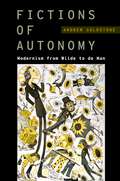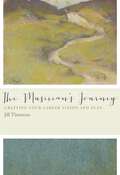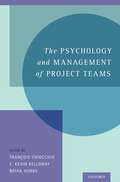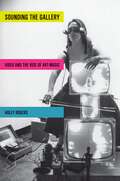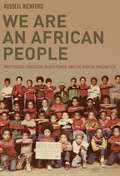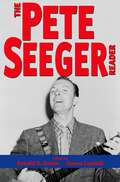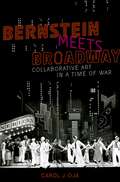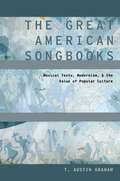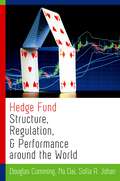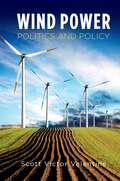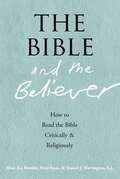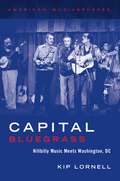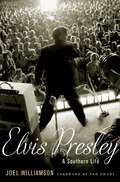- Table View
- List View
Fictions of Autonomy: Modernism from Wilde to de Man (Modernist Literature and Culture)
by Andrew GoldstoneNo aspect of modernist literature has attracted more passionate defenses, or more furious denunciations, than its affinity for the idea of autonomy. A belief in art as a law unto itself is central to the work of many writers from the late nineteenth century to the present. But is this belief just a way of denying art's social contexts, its roots in the lives of its creators, its political and ethical obligations? Fictions of Autonomy argues that the concept of autonomy is, on the contrary, essential for understanding modernism historically. Disputing the prevailing skepticism about autonomy, Andrew Goldstone shows that the pursuit of relative independence within society is modernism's distinctive way of relating to its contexts. Modernist autonomy is grounded in connections to servants and audiences, aging bodies and wardrobe choices; it joins T.S. Eliot to Adorno as exponents of late style and Djuna Barnes to Joyce as anti-communal cosmopolitans. Autonomy reveals new affinities across an expansive modernist field from Henry James and Proust to Stevens and de Man. Drawing on Bourdieu's sociology, formalist reading, and historical contextualization, this book shows autonomy's range--and its limitations--as a modernist mode of social practice. Nothing less than an argument for a wholesale revision of the assumptions of modernist studies, Fictions of Autonomy is also an intervention in literary theory. This book shows why anyone interested in literary history, the sociology of culture, and aesthetics needs to take account of the social, stylistic, and political significance of the problem, and the potential, of autonomy.
Fabrication Engineering At The Micro- And Nanoscale (The\oxford Series In Electrical And Computer Engineering)
by Stephen A. CampbellDesigned for advanced undergraduate or first-year graduate courses in semiconductor or microelectronic fabrication, Fabrication Engineering at the Micro- and Nanoscale, Fourth Edition, covers the entire basic unit processes used to fabricate integrated circuits and other devices. With many worked examples and detailed illustrations, this engaging introduction provides the tools needed to understand the frontiers of fabrication processes.
The Musician's Journey: Crafting Your Career Vision and Plan
by Dr. Jill TimmonsThe Musician's Journey escorts musicians, performing artists, music teachers, and advanced music students along the road toward a successful career, offering a vast array of resources to guide them from envisioning the process to achieving the practical details. Jill Timmons provides key tools throughout the journey, from sources as diverse as the world of myth to current brain research, which illuminate compelling real-world examples of music entrepreneurs who forged their own paths to success. Included are chapters on careers in higher education; guidance in how to develop a business plan; general tips on grant writing and financial development; a separate section exploring the stories of other successful musicians; and personal narrative taken from the author's work as a professional musician and consultant. The book includes an extensive bibliography of additional resources, and the companion website offers downloadable worksheets and questionnaires to help readers along their way.
The Psychology and Management of Project Teams
by François Chiocchio E. Kevin Kelloway Brian HobbsOrganizations today are increasingly using projects in their daily activities. Projects and project-management principles frame goal attainment in academia and many business sectors, and they even serve as theoretical footing for organizational-change endeavors. However, the ubiquity of project management does not mean that project work, project teams, and the ways organizations use projects are well understood. Moreover, while project-management theory and practice aim at providing structure and control to enable successful project completion, an alarmingly high percentage of projects struggle or fail. As the authors of The Psychology and Management of Project Teams explain, this is in part because projects are still mostly managed as technical systems rather than behavioral systems. Even though project-management researchers have become increasingly interested in factors that may have an impact on project-management effectiveness, their efforts fall short of addressing the "human factor." And, unfortunately, many project-management scholars are largely unaware of the I/O psychology literature--relying, for example, on outdated models of motivation and team development. On the other side, I/O psychologists who research groups and teams often ignore the contextual influences--such as business sector, project type, placement in the organizational hierarchy, and project phase and maturity--that have a crucial impact on how a project will unfold. In this volume, a cross-disciplinary set of editors will bring together perspectives from leading I/O psychology and project-management scholars. The volume will include comprehensive coverage of team selection, development, learning, motivation, and communication; conflict management and well-being; leadership; diversity; performance from a multi-level perspective; and career development. In the concluding chapter, a research agenda will provide a roadmap for an integrated approach to the study of project teams.
Sounding the Gallery: Video and the Rise of Art-Music (Oxford Music / Media)
by Holly RogersBecoming commercially available in the mid 1960s, video quickly became integral to the intense experimentalism of New York City's music and art scenes. The medium was able to record image and sound at the same time, which allowed composers to visualize their music and artists to sound their images. But as well as creating unprecedented forms of audiovisuality, video work also producedinteractive spaces that questioned conventional habits of music and art consumption. This book explores the first decade of creative video work, focusing on the ways in which video technology was used to dissolve the boundaries between art and music.
We Are an African People: Independent Education, Black Power, and the Radical Imagination
by Russell RickfordDuring the height of the Black Power movement of the late 1960s and 1970s, dozens of Pan African nationalist private schools, from preschools to post-secondary ventures, appeared in urban settings across the United States. The small, independent enterprises were often accused of teaching hate and were routinely harassed by authorities. Yet these institutions served as critical mechanisms for transmitting black consciousness. Founded by activist-intellectuals and other radicalized veterans of the civil rights movement, the schools strove not simply to bolster the academic skills and self-esteem of inner-city African-American youth but also to decolonize minds and foster a vigorous and regenerative sense of African identity. In We Are An African People, historian Russell Rickford traces the intellectual lives of these autonomous black institutions, established dedicated to pursuing the self-determination that the integrationist civil rights movement had failed to provide. Influenced by Third World theorists and anticolonial campaigns, organizers of the schools saw formal education as a means of creating a vanguard of young activists devoted to the struggle for black political sovereignty throughout the world. Most of the institutions were short-lived, and they offered only modest numbers of children a genuine alternative to substandard, inner-city public schools. Yet their stories reveal much about Pan Africanism as a social and intellectual movement and as a key part of an indigenous black nationalism. Rickford uses this largely forgotten movement to explore a particularly fertile period of political, cultural, and social revitalization that strove to revolutionize African American life and envision an alternate society. Reframing the post-civil rights era as a period of innovative organizing, he depicts the prelude to the modern Afrocentric movement and contributes to the ongoing conversation about urban educational reform, race, and identity.
The School Services Sourcebook, Second Edition: A Guide for School-Based Professionals
by Cynthia Franklin Mary Beth Harris Paula Allen-MearesThe School Services Sourcebook covers every aspect of school service delivery, arming practitioners with the nuts and bolts of evidence-based practice. The second edition has been significantly revised with a new structure including 73 chapters divided into five Parts across thirteen Sections, with an additional six chapters included in an online section found on the book's companion website. Fifteen new chapters cover key topics such as implementing an RTI framework, positive behavioral supports, school climate, functional behavioral assessment, the integration of ethics, Autism and suicide, school engagement, military families, Latino immigrant families, classroom management, transition planning and several chapters that speak to assessment and accountability. Each chapter serves as a detailed intervention map, quickly summarizing the problem area before presenting step-by-step instructions on how to implement an evidence-based program with clear goals in mind and methods to measure the outcome. The concise, user-friendly format from the first edition has been retained, orienting readers to each issue with a Getting Started section, then moves smoothly into What We Know, What We Can Do, Tools and Practice Examples, and Key Points to Remember. A new section, Applying Interventions within Response-to-Intervention Framework, has been added to each chapter to facilitate the implementation of an RTI model. Quick-reference tables and charts highlight the most important information needed for daily reference, and annotated lists of further reading and Web resources guide readers in gathering additional information to tailor their practice to suit their students' needs. Each chapter has been specifically crafted by leaders in their fields with the ultimate goal of giving school-based practitioners the tools they need to deliver the best mental health and social services possible to students, families, and communities. This sourcebook is an invaluable reference for all school-based social workers, psychologists, counselors, mental health professionals, educators, and administrators. Visit the companion website for more information and to access additional book content: [URL]
Everywhere and Nowhere: Contemporary Feminism in the United States
by Jo RegerChallenging the idea that feminism in the United States is dead or in decline, Everywhere and Nowhere examines the contours of contemporary feminism. Through a nuanced investigation of three feminist communities, Jo Reger shows how contemporary feminists react to the local environment currently shaping their identities, tactics, discourse, and relations with other feminist generations. By moving the analysis to the community level, Reger illustrates how feminism is simultaneously absent from the national, popular culture--"nowhere"--and diffused into the foundations of American culture--"everywhere." Reger addresses some of the most debated topics concerning feminists in the twenty-first century. How do contemporary feminists think of the second-wave generation? Has contemporary feminism succeeded in addressing racism and classism, and created a more inclusive movement? How are contemporary feminists dealing with their legacy of gender, sex, and sexuality in a world of fluid identity and queer politics? The answers, she finds, vary by community. Everywhere and Nowhere offers a clear, empirical analysis of the state of contemporary feminism while also revealing the fascinating and increasingly complex development of community-level feminist groups in the United States.
The Pete Seeger Reader (Readers on American Musicians)
by Ronald D. Cohen James CapaldiPerhaps the most widely recognized figure in folk music and one of the most well-known figures in American political activism, Pete Seeger now belongs among the icons of 20th-century American culture. The road to his current status as activist and respected voice of folk music was long and often rough, starting from the moment he dropped out of Harvard in the late 1930s and picked up a banjo. Editors Ronald Cohen and James Capaldi trace Seeger's long and storied career, focusing on his work as not only a singer, but also on his substantial contributions as an educator, songwriter, organizer, publisher, and journalist. The son of musicians, Seeger began his musical career before World War II and became well-known in the 1950s as a member of the commercially popular Weavers, only to be blacklisted by much of the mainstream media in the 1960s because of his progressive politics, and to return to the music scene in subsequent decades as a tireless educator and activist. The Pete Seeger Reader gathers writings from numerous sources, mixing Seeger's own work with that of the many people who have, over the years, written about him. Many of the pieces have never before been republished, and cover his entire career. A figure of amazing productivity, influence, and longevity, Seeger is author of a life that has been both cast in heroic terms and vilified. The selections in this book draw from a full range of these perspectives and will inform as they entertain, bringing into focus the life and contributions of one of the most influential figures of the twentieth century.
Bernstein Meets Broadway: Collaborative Art in a Time of War (Broadway Legacies)
by Carol J. OjaWinner of the 2015 Music in American Culture Award from the American Musicological Society When Leonard Bernstein first arrived in New York City, he was an unknown artist working with other brilliant twentysomethings, notably Jerome Robbins, Betty Comden, and Adolph Green. By the end of the 1940s, these artists were world famous. Their collaborations defied artistic boundaries and subtly pushed a progressive political agenda, altering the landscape of musical theater, ballet, and nightclub comedy. In Bernstein Meets Broadway: Collaborative Art in a Time of War, award-winning author and scholar Carol J. Oja examines the early days of Bernstein's career during World War II, centering around the debut in 1944 of the Broadway musical On the Town and the ballet Fancy Free. As a composer and conductor, Bernstein experienced a meteoric rise to fame, thanks in no small part to his visionary colleagues. Together, they focused on urban contemporary life and popular culture, featuring as heroes the itinerant sailors who bore the brunt of military service. They were provocative both artistically and politically. In a time of race riots and Japanese internment camps, Bernstein and his collaborators featured African American performers and a Japanese American ballerina, staging a model of racial integration. Rather than accepting traditional distinctions between high and low art, Bernstein's music was wide-open, inspired by everything from opera and jazz to cartoons. Oja shapes a wide-ranging cultural history that captures a tumultuous moment in time. Bernstein Meets Broadway is an indispensable work for fans of Broadway musicals, dance, and American performance history.
The Great American Songbooks: Musical Texts, Modernism, and the Value of Popular Culture (Modernist Literature and Culture)
by T. Austin GrahamIn the late nineteenth and early twentieth centuries, American authors pioneered a mode of musical writing that quite literally resounded beyond the printed page. Novels gained soundtracks, poetry compelled its audiences to sing, and the ostensibly silent act of reading became anything but. The Great American Songbooks is the story of this literature, at once an overview of musical and authorial practice at the century's turn, an investigation into the sensory dimensions of reading, and a meditation on the effects that the popular arts have had on literary modernism. The writings of John Dos Passos, Theodore Dreiser, T.S. Eliot, F. Scott Fitzgerald, Langston Hughes, Jean Toomer, and Walt Whitman are heard in a new key; the performers and tunesmiths who inspired them have their stories told; and the music of the past, long out of print and fashion, is recapitulated and made available in digital form. A work of criticism situated at the crossroads of literary analysis, musicology, and cultural history, The Great American Songbooks demonstrates the importance of studying fiction and poetry from interdisciplinary perspectives, and it suggests new avenues for research in the dawning age of the digital humanities.
Psychocinematics: Exploring Cognition at the Movies
by Arthur P. ShimamuraLargely through trial and error, filmmakers have developed engaging techniques that capture our sensations, thoughts, and feelings. Philosophers and film theorists have thought deeply about the nature and impact of these techniques, yet few scientists have delved into empirical analyses of our movie experience-or what Arthur P. Shimamura has coined "psychocinematics." This edited volume introduces this exciting field by bringing together film theorists, philosophers, psychologists, and neuroscientists to consider the viability of a scientific approach to our movie experience.
Hedge Fund Structure, Regulation, and Performance around the World
by Douglas Cumming Na Dai Sofia A. JohanThis book uses data from a multitude of countries to explain how and why hedge fund markets differ around the world. The authors consider international differences in hedge fund regulation which include, but are not limited to, minimum capitalization requirements, restrictions on the location of key service providers, and different permissible distribution channels via private placements, banks, other regulated or non-regulated financial intermediaries, wrappers, investment managers and fund distribution companies.
The Oxford Handbook of American Islam (Oxford Handbooks)
Islam has been part of the increasingly complex American religious scene for well over a century, and was brought into more dramatic focus by the attacks of September 11, 2001. American Islam is practiced by a unique blend of immigrants and American-born Muslims. The immigrants have come from all corners of the world; they include rich and poor, well-educated and illiterate, those from upper and lower classes as well as economic and political refugees. The community's diversity has been enhanced by the conversion of African Americans, Latina/os, and others, making it the most heterogeneous Muslim community in the world. With an up-to-the-minute analysis by thirty of the top scholars in the field, this handbook covers the growth of Islam in America from the earliest Muslims to set foot on American soil to the current wave of Islamophobia. Topics covered include the development of African American Islam; pre- and post-WWII immigrants; Sunni, Shi`ite, sectarian and Sufi movements in America; the role and status of women, marriage, and family; and the Americanization of Islamic culture. Throughout these chapters the contributors explore the meaning of religious identity in the context of race, ethnicity, gender, and politics, both within the American Islamic community and in relation to international Islam.
Wind Power Politics and Policy
by Scott Victor ValentineThe wind power development policy community faces a conundrum. On the one hand, as the most commercially viable form of utility-scale renewable energy, the wind power industry has experienced in excess of ten-fold growth in total installed capacity over the past decade. On the other hand, installed wind power capacity still accounts for less than 2% of global electricity-generation capacity, despite the prevalence of studies indicating that, in certain situations, wind power can be a cheaper form of electricity than most fossil fuel alternatives. Accordingly, the most puzzling aspect of wind power development policy can be summed up in the following manner: given the global imperative to facilitate an expedient transition away from CO2-intensive energy technologies and the commercial viability of wind power, what is stopping the wind power industry from capturing higher market shares around the world? In Wind Power Politics and Policy, Scott Valentine examines this question from two angles. First, it presents an analysis of social, technical, economic and political (STEP) barriers which research shows tends to stymie wind power development. Case studies which examine phlegmatic wind power development in Japan, Taiwan, Australia and Canada are presented in order to demonstrate to the reader how these barriers manifest themselves in practice. Second, the book presents an analysis of STEP catalysts which have been linked to successful growth of wind power capacity in select nations. Four more case studies that examine the successful development of wind power in Denmark, Germany, the USA and China are put forth as practical examples of how supportive factors conflate to produce conditions that are conducive to growth of wind power markets. By examining its impediments and catalysts, the book will provide policymakers with insight into the types of factors that must be effectively managed in order to maximize wind power development.
Growing in Love and Wisdom: Tibetan Buddhist Sources for Christian Meditation
by Susan J. StabileAlthough raised Roman Catholic, Susan Stabile was ordained as a Tibetan Buddhist nun and devoted 20 years of her life to practicing Buddhism before returning to Catholicism in 2001. In Growing in Love and Wisdom, she draws on this unique dual perspective to explore the value of interreligious dialogue, the spiritual dynamics that operate across faith traditions, and how Buddhist meditation practices can deepen Christian prayer. She begins by examining the values and principles shared by the two faiths and shows that both traditions seek to effect a fundamental transformation in the lives of believers. Both stress the need for experiences with deep emotional resonance that goes beyond the level of concepts to touch the heart. The center of the book offers 15 Tibetan Buddhist contemplative practices, adapted for Christian use. Stabile provides clear instructions on how to do these meditations and helpful commentary on each, explaining its purpose and the relation between the Buddhist original and her Christian adaptation of it. Throughout, she highlights the many remarkably close parallels between the teachings of Jesus and the Buddha. The meditations offered in this unusual book will be extremely useful to thoughtful Christians, to those responsible for giving spiritual direction, and also to Buddhist sympathizers who will be intrigued and pleased to see familiar contemplations handled so skillfully by a former Buddhist practitioner who has gratefully learned so much from her former religion and now introduces the riches of that tradition to her fellow Christians.
On Loving Our Enemies: Essays in Moral Psychology
by Jerome NeuThis book explores moral questions that go beyond the issues commonly considered in the ethics of action.
The Bible and the Believer: How to Read the Bible Critically and Religiously
by Marc Zvi Brettler Peter Enns Daniel J. HarringtonCan the Bible be approached both as sacred scripture and as a historical and literary text? For many people, it must be one or the other. How can we read the Bible both ways? The Bible and the Believer brings together three distinguished biblical scholars--one Jewish, one Catholic, and one Protestant--to illustrate how to read the Hebrew Bible/ Old Testament critically and religiously. Marc Zvi Brettler, Peter Enns, and Daniel J. Harrington tackle a dilemma that not only haunts biblical scholarship today, but also disturbs students and others exposed to biblical criticism for the first time, either in university courses or through their own reading. Failure to resolve these conflicting interpretive strategies often results in rejection of either the critical approach or the religious approach--or both. But the authors demonstrate how biblical criticism--the process of establishing the original contextual meaning of biblical texts with the tools of literary and historical analysis--need not undermine religious interpretations of the Bible, but can in fact enhance them. They show how awareness of new archeological evidence, cultural context, literary form, and other tools of historical criticism can provide the necessary preparation for a sound religious reading. And they argue that the challenges such study raises for religious belief should be brought into conversation with religious tradition rather than deemed grounds for dismissing either that tradition or biblical criticism. Guiding readers through the history of biblical exegesis within the Jewish, Catholic, and Protestant faith traditions, The Bible and the Believer bridges an age-old gap between critical and religious approaches to the Old Testament.
Srinatha: The Poet who Made Gods and Kings
by Velcheru Narayana Rao David ShulmanDavid Shulman and Velcheru Narayana Rao offer a groundbreaking cultural biography of Srinatha, arguably the most creative figure in the thousand-year history of Telugu literature. Their study, which includes extensive translations of Srinatha's major works, shows the poet's place in a great classical tradition in a moment of profound cultural transformation.
Passing on the Right: Conservative Professors in the Progressive University
by Jon A. Shields Joshua M. Dunn Sr.Few seem to think conservatives should become professors. While the left fears an invasion of their citadel by conservatives marching to orders from the Koch brothers, the right steers young conservatives away from a professorial vocation by lampooning its leftism. Shields and Dunn quiet these fears by shedding light on the hidden world of conservative professors through 153 interviews. Most conservative professors told them that the university is a far more tolerant place than its right-wing critics imagine. Many, in fact, first turned right in the university itself, while others say they feel more at home in academia than in the Republican Party. Even so, being a conservative in the progressive university can be challenging. Many professors admit to closeting themselves prior to tenure by passing as liberals. Some openly conservative professors even say they were badly mistreated on account of their politics, especially those who ventured into politicized disciplines or expressed culturally conservative views. Despite real challenges, the many successful professors interviewed by Shields and Dunn show that conservatives can survive and sometimes thrive in one of America's most progressive professions. And this means that liberals and conservatives need to rethink the place of conservatives in academia. Liberals should take the high road by becoming more principled advocates of diversity, especially since conservative professors are rarely close-minded or combatants in a right-wing war against the university. Movement conservatives, meanwhile, should de-escalate its polemical war against the university, especially since it inadvertently helps cement progressives' troubled rule over academia.
Aleister Crowley and Western Esotericism
by Henrik Bogdan Martin P. StarrThis volume is the first comprehensive examination of one of the twentieth century's most distinctive iconoclasts. Aleister Crowley (1875-1947) was a study in contradictions. Born into a fundamentalist Christian family and educated at Cambridge, he was vilified as a traitor, drug addict, and debaucher, yet revered as perhaps the most influential thinker in contemporary esotericism. Moving beyond the influence of contemporary psychology and the modernist understanding of the occult, Crowley declared himself the revelator of a new age of individualism. Crowley's occult bricolage, Magick, was an eclectic combination of spiritual exercises drawn from Western European magical ceremonies and Indic sources for meditation and yoga. This journey of self-liberation culminated in harnessing sexual power as a magical discipline, a "sacrilization of the self" as practiced in Crowley's mixed masonic group, the Ordo Templi Orientis. The religion Crowley created, Thelema, legitimated his role as a charismatic revelator and herald of a new age of freedom. Aleister Crowley's lasting influence can be seen in the counter-culture movement of the late 1960s and early 1970s and in many forms of alternative spirituality and popular culture. The essays in this volume offer crucial insight into Crowley's foundational role in the study of Western esotericism, new religious movements, and sexuality.
Capital Bluegrass: Hillbilly Music Meets Washington, DC (American Musicspheres)
by Kip LornellWith its rich but underappreciated musical heritage, Washington, D.C. is often overlooked as a cradle for punk, the birthplace of go go, and as the urban center for bluegrass in the Untied States. Capital Bluegrass: Hillbilly Music Meets Washington, D.C. richly documents the history and development of bluegrass in and around the nation's capital since it emerged in the 1950s. In his seventeenth book, American vernacular music scholar Kip Lornell discusses both well-known progressive bluegrass bands including the Country Gentlemen and the Seldom Scene, and lesser known groups like the Happy Melody Boys, Benny and Vallie Cain and the Country Clan, and Foggy Bottom. Lornell focuses on colorful figures such as the brilliant and eccentric mandolin player, Buzz Busby, and Connie B. Gay, who helped found the Country Music Association in Nashville. Moving beyond the musicians to the institutions that were central to the development of the genre, Lornell brings the reader into the nationally recognized Birchmere Music Hall, and tunes in to NPR powerhouse WAMU-FM, which for five decades broadcast as much as 40 hours a week of bluegrass programming. Dozens of images illuminate the story of bluegrass in the D.C. area, photographs and flyers that will be new to even the most veteran bluegrass enthusiast. Bringing to life a music and musical community integral to the history of the city itself, Capital Bluegrass tells an essential tale of bluegrass in the United States.
The Face on Film
by Noa SteimatskyThe human face was said to be rediscovered with the advent of motion pictures, in which it is often viewed as expressive locus, as figure, and even as essence of the cinema. But how has the modern, technological, mass-circulating art revealed the face in ways that are also distinct from any other medium? How has it altered our perception of this quintessential incarnation of the person? The archaic powers of masks and icons, the fashioning of the individual in the humanist portrait, the modernist anxieties of fragmentation and de-figuration--these are among the cultural precedents informing our experience in the movie theatre. Yet the moving image also offers radical new confrontations with the face: Dreyer's Passion of Joan of Arc, Donen's Funny Face, Hitchcock's The Wrong Man, Bresson's enigmatic Au hasard Balthazar, Antonioni's Screen Test, Warhol's filmic portraits of celebrity and anonymity are among the key works explored in this book. In different ways these intense encounters manifest a desire for transparency and plenitude, but--especially in post-classical cinema--they also betray a profound ambiguity that haunts the human countenance as it wavers between image and language, between what we see and what we know. The spectacular impact of the cinematic face is uncannily bound up with an opacity, a reticence. But is it not for this very reason that, like faces in the world, it still enthralls us?
Elvis Presley: A Southern Life
by Joel WilliamsonIn Elvis Presley: A Southern Life, one of the most admired Southern historians of our time takes on one of the greatest cultural icons of all time. The result is a masterpiece: a vivid, gripping biography, set against the rich backdrop of Southern society--indeed, American society--in the second half of the twentieth century. Author of The Crucible of Race and William Faulkner and Southern History, Joel Williamson is a renowned historian known for his inimitable and compelling narrative style. In this tour de force biography, he captures the drama of Presley's career set against the popular culture of the post-World War II South. Born in Tupelo, Mississippi, Presley was a contradiction, flamboyant in pegged black pants with pink stripes, yet soft-spoken, respectfully courting a decent girl from church. Then he wandered into Sun Records, and everything changed. "I was scared stiff," Elvis recalled about his first time performing on stage. "Everyone was hollering and I didn't know what they were hollering at." Girls did the hollering--at his snarl and swagger. Williamson calls it "the revolution of the Elvis girls." His fans lived in an intense moment, this generation raised by their mothers while their fathers were away at war, whose lives were transformed by an exodus from the countryside to Southern cities, a postwar culture of consumption, and a striving for upward mobility. They came of age in the era of the 1954 Brown vs. Board of Education ruling, which turned high schools into battlegrounds of race. Explosively, white girls went wild for a white man inspired by and singing black music while "wiggling" erotically. Elvis, Williamson argues, gave his female fans an opportunity to break free from straitlaced Southern society and express themselves sexually, if only for a few hours at a time. Rather than focusing on Elvis's music and the music industry, Elvis Presley: A Southern Life illuminates the zenith of his career, his period of deepest creativity, which captured a legion of fans and kept them fervently loyal for decades. Williamson shows how Elvis himself changed--and didn't. In the latter part of his career, when he performed regular gigs in Las Vegas and toured second-tier cities, he moved beyond the South to a national audience who had bought his albums and watched his movies. Yet the makeup of his fan base did not substantially change, nor did Elvis himself ever move up the Southern class ladder despite his wealth. Even as he aged and his life was cut short, he maintained his iconic status, becoming arguably larger in death than in life as droves of fans continue to pay homage to him at Graceland. Appreciative and unsparing, culturally attuned and socially revealing, Williamson's Elvis Presley will deepen our understanding of the man and his times.
Molecular Relaxation in Liquids
by Biman BagchiThis book brings together many different relaxation phenomena in liquids under a common umbrella and provides a unified view of apparently diverse phenomena. It aligns recent experimental results obtained with modern techniques with recent theoretical developments. Such close interaction between experiment and theory in this area goes back to the works of Einstein, Smoluchowski, Kramers' and de Gennes. Development of ultrafast laser spectroscopy recently allowed study of various relaxation processes directly in the time domain, with time scales going down to picosecond (ps) and femtosecond (fs) time scales. This was a remarkable advance because many of the fundamental chemical processes occur precisely in this range and was inaccessible before the 1980s. Since then, an enormous wealth of information has been generated by many groups around the world, who have discovered many interesting phenomena that has fueled further growth in this field. As emphasized throughout the book, the seemingly different phenomena studied in this area are often closely related at a fundamental level. Biman Bagchi explains why relatively small although fairly sophisticated theoretical tools have been successful in explaining a wealth of experimental data at a semi-phenomenological level.
